Prof. Dr. Karlheinz Meier’s Colleagues Pay Tribute To An HBP Hero
29 October 2018
Prof. Dr. Karlheinz Meier was one of the founders of the Human Brain Project, and a member of the project’s executive management board, the Directorate, during the ramp-up phase. He was also Co-chair of the Project’s scientific leadership body - the HBP Science and Infrastructure Board (SIB) - responsible for Infrastructure Operations and, ex-officio, Infrastructure Operations Director. Last week, on Wednesday 24 October, Professor Meier - who had been ill for some time - suddenly passed away. Below his colleagues at the Human Brain Project pay tribute to Karlheinz Meier’s extraordinary contribution to the Human Brain Project.
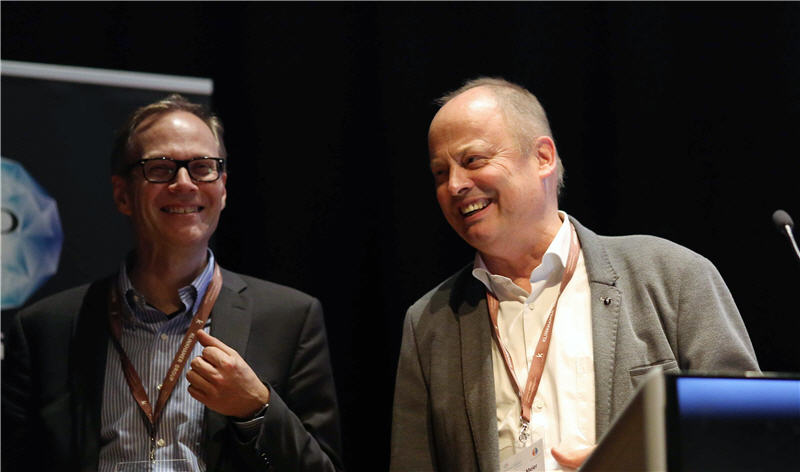
Dr. Karlheinz Meier right with Jan G. Bjaalie at the HBP Summit in Maastricht on Oct. 16th 2018 - Image: Bjoern Kindler (HBP)
Prof. Dr. Karlheinz Meier was one of the founders of the Human Brain Project, and a member of the project’s executive management board, the Directorate, during the ramp-up phase. He was also Co-chair of the Project’s scientific leadership body - the HBP Science and Infrastructure Board (SIB) - responsible for Infrastructure Operations and, ex-officio, Infrastructure Operations Director.
From 15th to the 18th of October Professor Meier spent several days at the annual HBP Summit meeting in Maastricht where the above picture was taken. He was lively and well. Last week, on Wednesday 24 October, Professor Meier - who had been ill for some time - suddenly passed away. Below his colleagues at the Human Brain Project pay tribute to Karlheinz Meier’s extraordinary contribution to the Human Brain Project.
Organisational Tributes
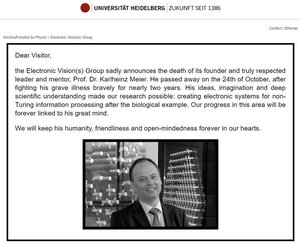
“The Electronic Vision(s) Group sadly announces the death of its founder and truly respected leader and mentor, Prof. Dr. Karlheinz Meier. He died suddenly and unexpectedly on 24th of October. His ideas, imagination and deep scientific understanding made our research possible: creating electronic systems for non-Turing information processing after the biological example. Our progress in this area will be forever linked to his great mind.We will keep his humanity, friendliness and open-mindedness forever in our hearts.” - Heidelberg University
******
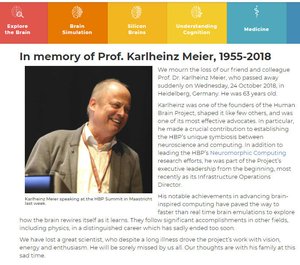 “We mourn the loss of our friend and colleague Prof. Dr. Karlheinz Meier, who passed away suddenly on Wednesday, 24 October 2018, in Heidelberg, Germany. He was 63 years old.
“We mourn the loss of our friend and colleague Prof. Dr. Karlheinz Meier, who passed away suddenly on Wednesday, 24 October 2018, in Heidelberg, Germany. He was 63 years old.
Karlheinz was one of the founders of the Human Brain Project, shaped it like few others, and was one of its most effective advocates. In particular, he made a crucial contribution to establishing the HBP’s unique symbiosis between neuroscience and computing. In addition to leading the HBP’s Neuromorphic Computing research efforts, he was part of the Project’s executive leadership from the beginning, most recently as its Infrastructure Operations Director.
His notable achievements in advancing brain-inspired computing have paved the way to faster than real time brain emulations to explore how the brain rewires itself as it learns. They follow significant accomplishments in other fields, including physics, in a distinguished career which has sadly ended too soon.
We have lost a great scientist, who despite a long illness drove the project’s work with vision, energy and enthusiasm. He will be sorely missed by us all. Our thoughts are with his family at this sad time.“- Katrin Amunts, Andreas Mortensen and Christian Fauteux on behalf of the Human Brain Project
Collegial Tributes
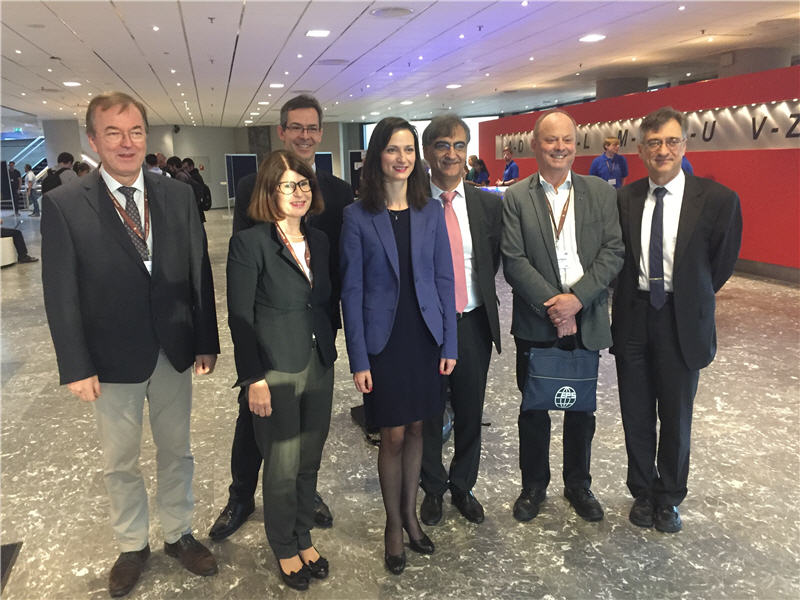
From left: Thomas Lippert (HBP), Kartrin Amunts (HBP), Jean-François Buggenhout (EC), European Commissioner for Digital Economy and Society Mariya Gabriel , Thomas Skordas(EC), Karlheinz Meier (EC) and Andreas Mortensen (HBP Director General) pictured during the first day of the 2019 Human Brain Project Summit in Maastricht. Netherlands.
Karlheinz was an exceptional colleague, infinite source of inspiration for the HBP, and a close friend. His sharp mind, leadership abilities, skills, enthusiasm, positivity, joy of discovery, but also his ability to work hard and move things, all impressed me. His death leaves a massive gap in the project, and I feel deeply touched and saddened by his loss.
Katrin Amunts,
SIB Chair / HBP Scientific Research Director
*****
Karlheinz Meier was one of the giants – a master of theory, well-experienced in practice, an organizational talent, a gifted teacher. But most of all, a true visionary. He had an agenda – neuromorphic computing – and he pursued this vision with unwavering discipline. Armed with an enviable knowledge of physics, supplemented by his in-depth experience with DESY, CERN and his work at the University of Heidelberg, he was the driver and coordinator of EU projects SenseMaker, FACETS-ITN, BrainScales, which were all projects that paved the way for the ultimate project : HBP. The Human Brain Project would have never been possible without KHM, and he played a well-deserved leadership role, for which he even gave up his own flagship proposal.
He leaves us at a time after he very energetically had prepared the next step in HBP, in particular, the structure of the phase which will come after the ten year funding period. Just last week, there were lively discussions within the Board of Directors about finding the optimal way to do this, resulting, as usual, in a consensus. One of the last emails that KHM sent to the Board of Directors ended with his usual, unmistakable “ I approve. Karlheinz”. May he rest in peace and may his spirit, talent and determination energize HBP’s future endeavors. He will be missed.
Alois Knoll
HBP Software Development Director
Leader SP10 - Neurorobotics Platform
*****
Karlheinz had big ideas and moved mountains. His dream of neuromorphic computing will not be forgotten and his legacy for having pushed it so far will last eternally. But above all, what he has done for others will be felt far into the future.
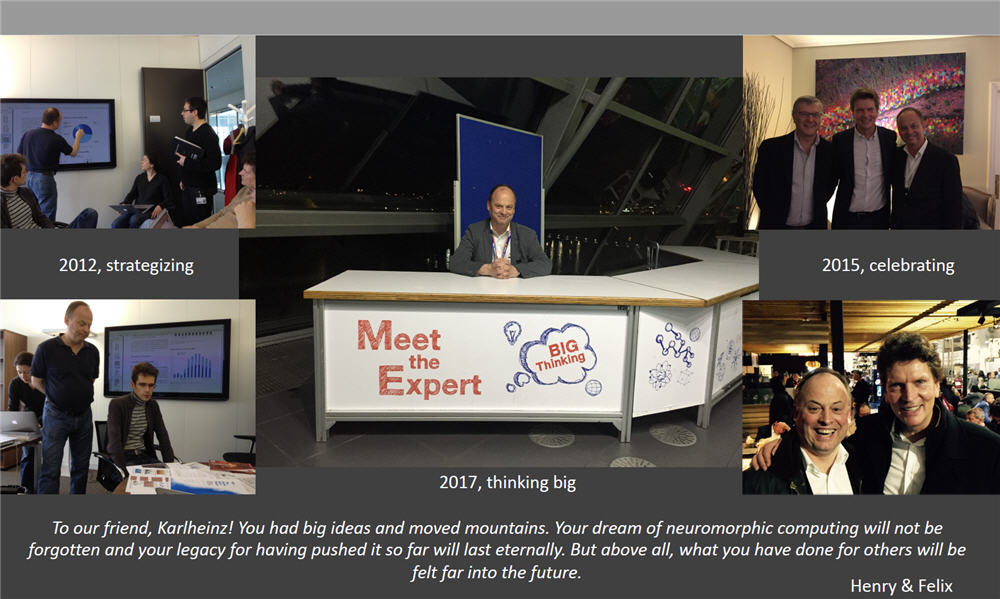
Tribute Image from Henry Markram and Felix Schürmann
Henry Markram and Felix Schürmann
SP6 – Brain Simulation Platform Leader and Deputy Leader
[NOTE: Henry Markram was a Co-Founder of the Human Brain Project]
*****
Karlheinz Meier was a great man and scientist, finally damaged by a horrible disease which he fought valiantly and with a clear mind to the end. His legacy is neuromorphic computing and the doors he opened for generations to come by piloting the informatics component of the successful application for funding the Human Brain Project. It was difficult not to seek his company even when viewpoints differed. When caught between a rock and a hard place, he navigated sensitively and was a gentleman to all. It was a pleasure to call him a friend through thick and thin.
Richard Frackowiak
Former Head of Neurology, Centre hospitalier universitaire vaudois (CHUV)
Co-Founder of the Human Brain Project
*****
Karlheinz provided much of the vision behind the HBP Flagship, but my main connection with him was in his role as leader, and I his deputy, of SP9. Whenever he presented SP9 in public he was always careful to keep a balance between his own BrainScaleS project, where clearly his heart lay, and the SpiNNaker project, which I lead. His fairness and respect for the work of others in turn earned the respect that we all felt for him, and is an example we should all follow.
I was privileged to be invited to speak at the celebration Heidelberg held in honour of his 60th birthday in June 2015, and this photo is one I secretly took during the HBP Board meeting in Madrid the previous month to use in my talk. I think it captures his enthusiasm for HBP rather nicely!
Steve Furber
Deputy Leader SP9 - Neuromorphic Computing Platform
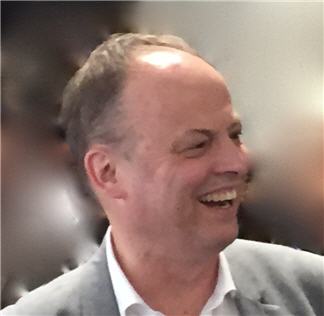
Image: Steve Furber
******
When Karlheinz spoke about extraordinary achievements of colleagues within HBP, he sometimes used the phrase « that XX/XY enters for him on the list of HBP heroes »… I have always felt that this is not a bad wording and Karlheinz himself should be somewhere on the top of this list.
Viktor Jirsa
SP4 - Theoretical Neuroscience Deputy Leader
*****
UPDATE 19 November 2018:
I first met Karlheinz when I joined the UA2 experiment at CERN, Geneva in 1986. I worked with him over the next five years and had an enormously exciting and intellectually stimulating time working with him. During a visit to Heidelberg in 2009 I learnt about Karlheinz's early neuromorphic computing research, in which CERN particle physics technology was being harnessed to simulate the brain and understand how it works. Karlheinz's research was highly creative and ingenious and his work leaves a profound neuroscientific legacy that will have a lasting impact. Karlheinz and his wife Annette visited Melbourne in 2017 where he gave a number of stimulating public lectures on neuromorphic computing and the BrainScaleS project to packed lecture theatres, and we were able to catch up again just a couple of months ago in Heidelberg. Karlheinz was an intellectual force, an outstanding colleague and a true friend. I was greatly saddened to hear of his premature passing.
Gary Egan
Melbourne
10 November, 2018
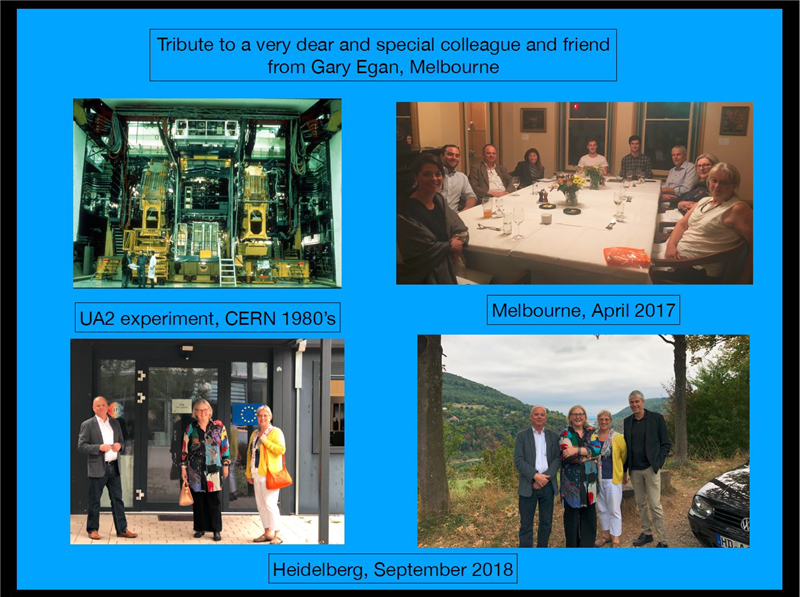
*****
UPDATES 13 November 2018:
*****
Dear Annette, Dear Friends,
I have known Karlheinz for almost 20 years. Kirsty and I first met him at a think-tank meeting in the context of life-like, bio-inspired computing. The seriousness and intensity with which Karlheinz interacted with biologists struck us from the start. This first encounter resulted in an integrated project “SenseMaker” the aim of which was to emulate multimodal sensory integration, observed in the human brain, with neuromorphic architectures. As a consequence of our dicussions, Karlheinz decided to switch from classical McCulloch and Pitts formal neurons to spiking units where the chip hardware would solve instantaneously the differential equations of neuronal membrane dynamics. He and his colleagues at the Kirchhoff Institute in Heidelberg went on this electronic revolution, by endowing electronic spiking neurons with the non-linear conductances and adaptive synapses reported by biologists in real neuronal networks.
To cut a long story of fruitful and creative collaborations short, our combined efforts led to the constitution of a European excellence network and resulted in an impressive series of uninterrupted integrative FET projects (Sensemaker, FACETS, Brain-i-Nets and BrainScaleS). These projects were the starting point of scientific careers for more than 150 PhD students, some of them supported by a specific Marie-Curie training programme (Facets-ITN), an undisputable educational sign that attests to the birth of a new interdisciplinary field. This scientific effort extending over 15 years under the guidance of Karlheinz can be summarized as a coherent line of interdisciplinary research extracting generic principles of plasticity and integration from the in-vivo study of dynamic cortical networks to implement them in silico. These biological principles were to be implemented in VLSI parallel circuits to create a new type of computing architecture, inspired from the living brain. Such architecture by its parallelism and mixed analog-digital nature departs profoundly from von Neumann and Turing machines and the invariance of computing speed relative to the size and the complexity of the emulated network were seen, at that time, as a radical rupture in classical computing paradigms.
From Sensemaker to BrainScaleS, in spite of some changes in the consortium constitution, our collaboration went on uninterrupted and Karlheinz was all the way our charismatic leader. His organizational skills, already demonstrated during the leadership of large-scale physics projects that he led in the past – he had many lives ! - were most impressive for the biologist partners. His natural wisdom and kindness made strategic decisions acceptable to all partners, and the respect he showed to disciplines other than his own was obvious.
These collaborative projects had more profound consequences than technical or scientific deliverables. They influenced our way of doing science, by learning how to navigate through Europe and discovering the pleasure of working together, crossing over the boundaries; different disciplines, different cultures and administrations, several generations of European history to assimilate and go beyond.
Based on the initial success of these medium-size European projects, Karlheinz and some of us (Alain, Kirsty and I) embarked together on lobbying actions with the European Commission to find ways of extending the classical timescale of funding such risky techniques and go beyond the proof of concept. Progressively, Karlheinz moved to the management of megascience, which, by its scale of funding, would allow much faster implementation of novel microelectronic architectures. Naturally, doing so, he became the undisputed leader of European neuromorphic technology and one of the three main scientists leading the EC flagship « The Human Brain Project »
In spite of the difficulties that the launch of this one-billion-euro project had to accommodate – this was the first of its kind in the field of neuroscience-based IT – and in spite of the fact that some of his old biology partners, including me, disagreed more or less strongly with the emphasis on technology-driven research, Karlheinz and I remained close friends all along. We kept alive private moments when he was not travelling across the world as the emissary of new technological approaches in simulating the Brain. I have sweet and strong memories of these moments in some Sardinian taverna in Capo-Caccia where we reunited periodically our mutual friendship in front of a lobster and a vertimentino bottle. We always found time at the occasion of HBP meetings where we recalled the happy days of FACETS and BrainScaleS, which were so special to both of us. These were parentheses in our busy lives, where science was no longer a political or strategic debate, but a pure thought process and quest for better knowledge shared by scientist friends of different horizons. I never experienced such a strong bond before.
Not surprisingly, all of us at UNIC shared with him profound personal binding experiences. Karlheinz was a leader and his passing is indeed a profound loss. He leaves a legacy of warmth and willingness to boldly go where no man has gone before, within the people he has trained and allowed each to find their way. Our hope is that those who came along in the adventure can continue the same.
Karlheinz was a dear friend, a unique person, a Man of Science that we will always remember, a man of integrity whom we will honor, a man of vision for his physicist and biologist colleagues.
This letter was written on behalf of his friends at UNIC, and all the interdisciplinary PIs and students who participated in this incredible scientific journey under his guidance.
Director of UNIC and Biology coordinator of FACETS and BrainScaleS
*****
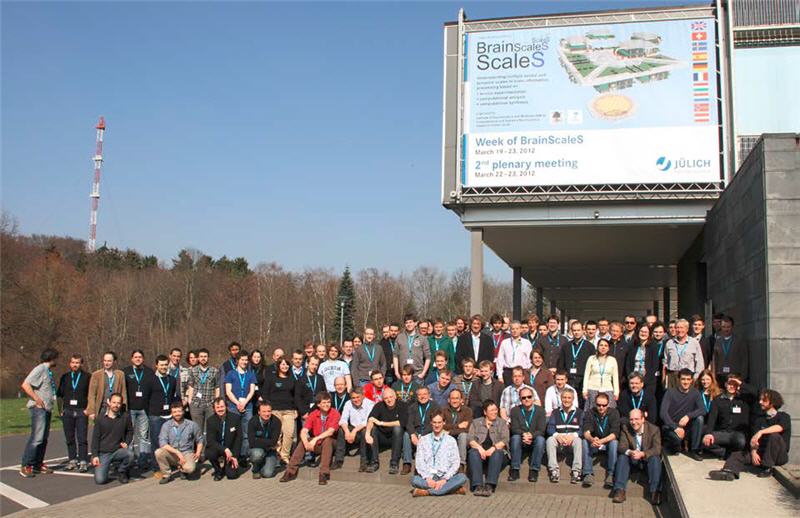
Karlheinz (front row, with sunglasses) and his BrainScaleS crew with most of us on the occasion of the annual BrainScaleS meeting in 2012 at Jülich. Moritz first from left in top row, Sonja to the right of Karlheinz, Markus third to his left, Sacha third from right in the front row.
Dear HBP Friends,
Karlheinz was our friend and colleague, and we will miss him. Of his considerable achievements in particle physics and neuromorphic hardware, and of his passionate engagement as a teacher and mentor, others can speak with greater eloquence. We would like to share our impressions on how he has affected our field of computational neuroscience.
We first got to know him during the preparation of the European FACETS project in 2004. This initiated a lasting and deepening collaboration through the BrainScaleS project leading to the Human Brain Project (HBP). Throughout this long period, Karlheinz impressed us time and again with his ability to be a "practical visionary". His insight that understanding the brain is a big science problem, coupled with his years of experience in the nuts and bolts of scientific investigations, transformed the way computational neuroscience is carried out.
At the outset of this sequence of European projects, computational neuroscience was in crisis. It was hardly possible to create and validate software in a sustainable manner and publish these results, large-scale collaboration was practically unheard of, and consequently little progress was made. Many of the ideas guiding us out of the dark ages originate from Karlheinz's influence on these projects and are still relevant today. The idea of approaching the endeavor of understanding the brain as a problem requiring ICT at a new scale, and that would advance ICT in fundamentally new ways, led to substantial European funding for basic neuroscience research over two decades from technology rather than health funds, thus benefiting the community as a whole and providing many opportunities for young people to enter this exciting field. As a result, two generations of computational neuroscientists educated in the collaborative framework of European projects led by Karlheinz are now professors all over Europe, including our own institute INM-6 at Jülich.
Beyond his intellectual and strategic contributions, Karlheinz created an atmosphere that made it possible for young researchers to develop responsibility and autonomy, and bring in their ideas, sometimes despite the resistance of seniors. Early examples of the kind of co-operative research and activities led by young scientists that flourished in this environment are the 2007 review on neural network simulation engines by Brette et al., the initiation of the CodeJam Workshops by Eilif Muller and Andrew Davison, and the establishment of interoperability of multiple simulators via the meta-simulator language PyNN.
While at the outset of FACETS there was the dream of a new type of computer without software and operating system, we soon realized to make the new hardware usable, we would need a whole 'software ecosystem', a term frequently used by Karlheinz. Consequently, in the subsequent BrainScaleS project, Karlheinz pushed us to develop demos that would cover the whole workflow, and to put more emphasis on incorporating data analysis. On the way we had to abandon some high-flying ideas to arrive at a set of working showcases. At the final review, the early NeuralEnsemble ideas had matured into the community effort Elephant.
With the hardware and software tools maturing, Karlheinz realized that the challenges facing neuroscience are much bigger than the usual funding schemes, and he developed plans for a European Flagship proposal. An international ICT infrastructure for neuroscience was required. Again, following his ideals of collaboration, he decided to merge his plans with those of other Flagship proposals in the domains of neuroscience
and supercomputing. This underlines his admirable personality and came not without sacrifices for Karlheinz. Historians may decide one day whether this was the only way to go. Until the last day Karlheinz was an intellectual and strategical leader of the HBP, an initiative which is unique world-wide in its scope from basic neuroscience to neuromorphic and exascale computing.
On a personal level, Karlheinz was a pleasure to know and spend time with. He was friendly and approachable, an entertaining speaker and an attentive listener, happy to take part in spontaneous social gatherings and relaxed in crisis situations, such as when stranded on the roadside in a rough area of town on the way to the airport in Cape Town. Our last personal encounter with Karlheinz was when he rode the bus together with Markus to the conference dinner of the HBP meeting. The conversation was all cheerful and forward-looking, ranging from future concepts of measuring energy consumption consistently, to how to place ICT for neuroscience on the European infrastructure roadmap. We have nothing but respect for his indefatigable optimism and enthusiasm for work and life.
The academic legacy of Karlheinz is beyond question. However, perhaps even more important to us is the collaborative multi-disciplinary spirit he brought to neuroscience. This is what we have to live up to and pass on to the next generation
For INM-6
Sacha van Albada, Markus Diesmann, Sonja Grün, Moritz Helias, Abigail Morrison
Institute of Neuroscience and Medicine- Jülich (Germany)
*****
It is with great sadness that we learned of the sudden passing of our colleague Prof. Karlheinz Meier. He made invaluable contributions to our program and will be remembered as one of the most enthusiastic advocates for the importance of an accompanying education programme from the beginning. His passion, kindness and support for the education team will be sorely missed.
Alois Saria & the HBP Education team (SP11)
HBP Education Pictures
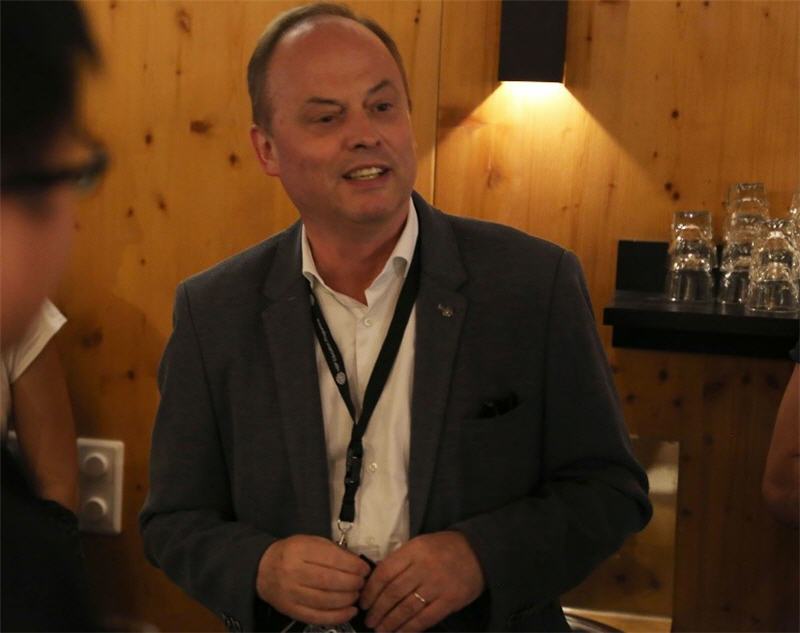
Karlheinz Meier at the 4th HBP School – Future Computing in Obergurgl, Austria. (Karlheinz was the Scientific Chair and designed the very well received program)

Karlheinz Meier with Dave Lester at the 4th HBP School – Future Computing in Obergurgl, Austria (handing out certificates to the students).
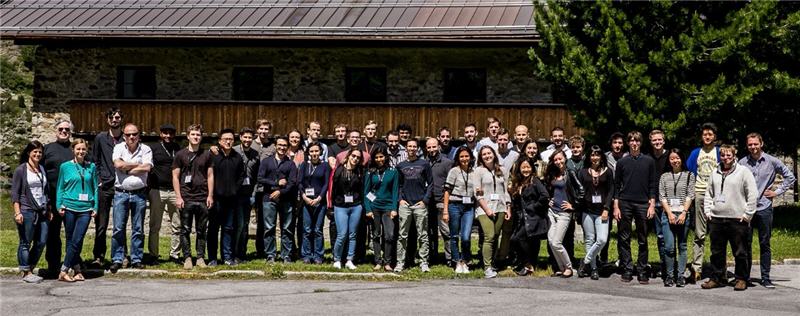
Group picture from the 4th HBP School in Obergurgl, Austria, June 2017.
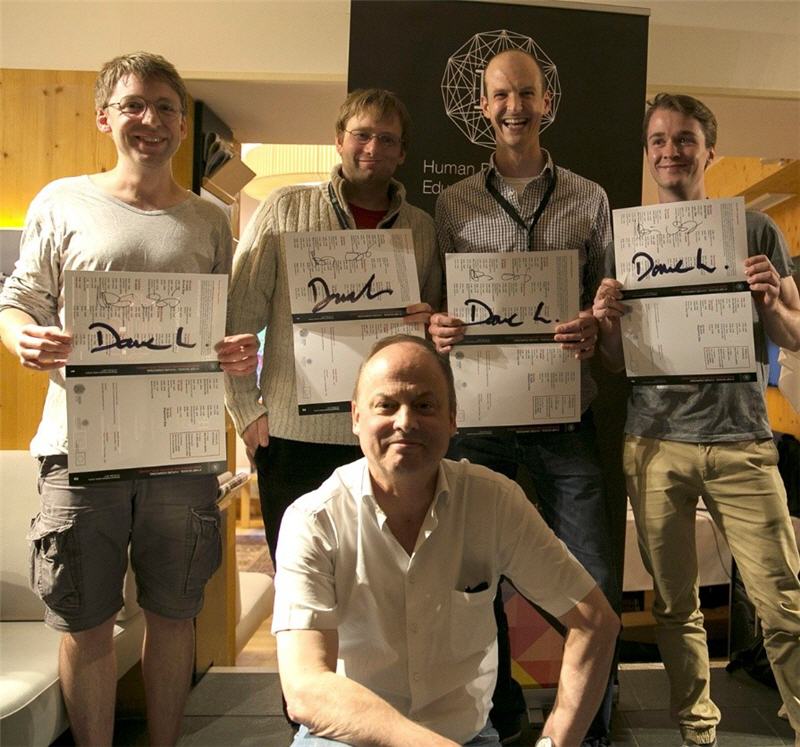
Some of the speakers and tutors of the 4th HBP School – Future Computing in Obergurgl, Austria, with Scientific Chair Karlheinz Meier. (June 2017)
*****
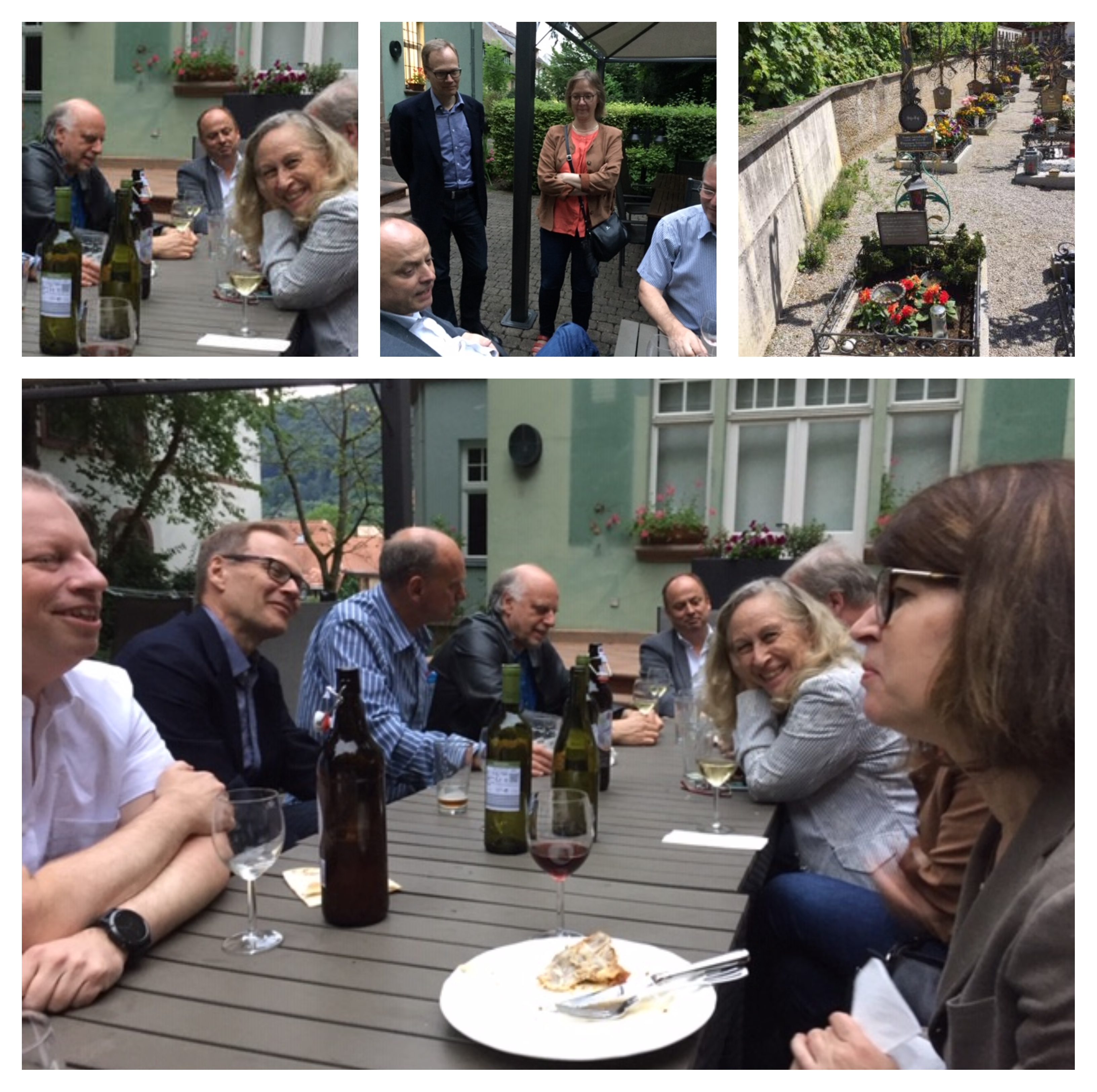
From Left: Chris Ebell, Jan G. Bjaalie, Cyriel Pennartz, Alain Destexhe, Karlheinz Meier, Mira Marcus, Thomas Lippert (obscured) & Kartrin Amunts - Images Jeam Pierre Changeux
Dear Katrin,
Dear Friends,
I just arrived in New-York to find your email and the news that Karlheinz has passed away.
This is a terrible shock and a profound sorrow for me, to lose one of my closest colleagues and friends in the Human Brain Project.
From the moment we first met, in the very early stages of HBP in Paris and Lausanne, we had a profound and constantly renewed intellectual exchange about the brain as a physical system - and the possibility of reproducing it as a neuromorphic machine - his view - at variance with my view of the brain as a chemical and molecular system, yet also being conscious and social.
Among the debates:
- Would it be possible to simulate plasticity though neuromodulation? His answer was yes, the neuromorphic device capabilities are there.
- Would it be plausible to incorporate 15 years of brain development in the neuromorphic construction of his machine? His answer was again yes, taking into account, in particular, the extremely high speed of the computer.
- And what about conscious processing and ethical behavior?
For Karlheinz the answer was always yes. But never simply yes, which would have been an ideological position. Instead we always had a long and elaborate debate, him the educated physicist, where each of the parties made considerable efforts to support their argument.
Karlheinz had, in my opinion, an immense role in HBP, as an intellectual leader and challenger. The breadth of his interest was immense from quantum physics to esthetics. He shall not easily be replaced.
Further, as a responsible scientist he was deeply concerned with enlarging the intellectual debate to include the entire HBP, and to set up global debates at the HBP scale. And he achieved this - despite resistance. In Malaga and in Alpbach - where we evoked together Erwin Schrödinger, while visiting his tomb we talked of these things.
This was a very moving moment in our close relationship: as headlines talked of the importance of conceptual thinking in physics, as it should also be in neuroscience, and, alas, about the proximity of his coming death.
Our last exchange in Maastricht was about monoclonal antibodies as allosteric modulators in fighting cancer. We did not agree on the target receptors, he was, unfortunately right.
We shall all remember Karlheinz as one of the most extraordinary intellectuals of our time, one with whom time spent was always extremely enriching. He was also an immensely generous human being, dedicated - deep to his full intimate conviction - to the success of the Human Brain Project.
An example for us for the future of HBP!
With my affectionate condolences to his family.
Emeritus Professor of Neuroscience at the Institut Pasteur and Collège de France
Eminent French Neuroscientist
SP8 HBP Project Participant
Recipient 2018 Albert Einstein World Award of Science
*****
I am very sorry to hear the sad news of the sudden passing of Karlheinz. I knew him since the beginning of the HBP, many years ago, and he became first a colleague and then a good friend. I am devastated to hear this bad news. He will be greatly missed by us all.
Javier DeFelipe
Leader SP1 - Mouse Brain Organisation and Interspecies Comparisons
*****
Karlheinz Meier was a great scientist and colleague. His deep thoughts inspired the Human Brain Project and all of us very much. I remember well that it was he who found the right decisive words in front of the panel in the very critical situation when the main project proposal was defended. Without him there would be no Human Brain Project. Karlheinz, we all owe you so much!
Thomas Lippert
Leader SP7 - High-Performance Analytics and Computing Platform
*****
Terrible and sad news. Karlheinz was one of the founders of the HBP, an outstanding and encouraging scholar and colleague and a strong positive force, exemplar to us all. He will be greatly missed. Our deepest sympathies are with his family during this difficult time.
Jan G. Bjaalie
Leader SP5 - Neuroinformatics Platform (on behalf of SP5)
*****
This is the saddest news indeed. We will greatly miss a wonderful friend, human and scientist. My condolences and thoughts are with his family.
Marc-Oliver Gewaltig
SP10 Neurorobotics Platform
*****
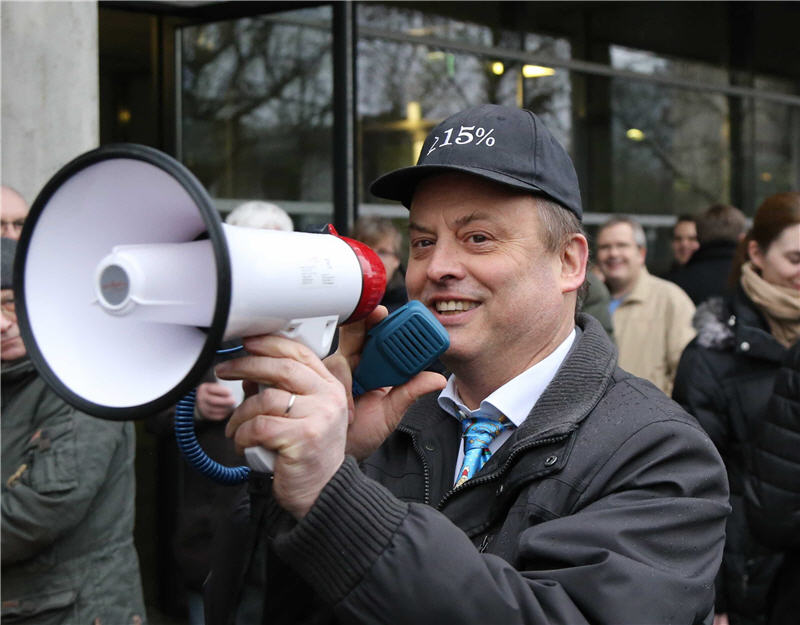
Karlheinz Meier on 20 December 2017: organising (here by megaphone) -Image: Bjoern Kindler (HBP)
*****
I agree with everything what is said about Karlheinz on this tribute page! Just to add: We organized a Discussion workshop “New horizons on Neuromorphic Computing with memristive devices”, on Ischia this year. Karlheinz gave a marvelous keynote lecture and contributed much to the manifold discussions. Much beyond the great science Karlheinz initiated and conducted for many years, I can still remember an evening on Ischia where I talked with Winfried Wilcke (IBM Almaden) and Karlheinz about our youth activities. I was particularly impressed that Karlheinz apparently successfully built rockets (which, according to my own experience, is not that easy). And there were many other stories that showed that he was an extraordinary man. We will greatly miss him!
Rainer Waser
Professor of Electrical Engineering and Information Technology, RWTH Aachen University
and Head of the Institute of Electronic Materials at the Peter Grünberg Institute, Forschungszentrum Jülich
*****
It is with great sadness that we heard of Karlheinz’ passing away. I have come to know Karlheinz as a strong, determined, inspiring person, yet friendly, supportive and of good humour. On a winter day a few years ago, he picked me up at the train station of Heidelberg, and we spent a wonderful day discussing with the Neuromorphic computing group at the University. Karlheinz excelled at organizing inspiring events like this and he was always very encouraging. Theoretically very gifted and broadly oriented, yet also pragmatic. I learned a lot from his style of communicating science and technology. Being a co-founder, visionary and staunch defender of HBP, I feel deeply about his loss, which calls for a continuation of his vision. Suffering from a major illness, he remained young in spirit and went too soon. I am proud to have been his colleague, but very sad that this can be no longer. My condolences to Karlheinz’ family, it was truly a privilege to work with this exceptional man.
Cyriel Pennartz
Leader SP3 - Systems and Cognitive Neuroscience
*****
Karlheinz was a person of great humanity,an incredible source of energy and inspiration for everyone who had the fortune to interact with him.
Pier Stanislao
SP3 - Systems and Cognitive Neuroscience
*****
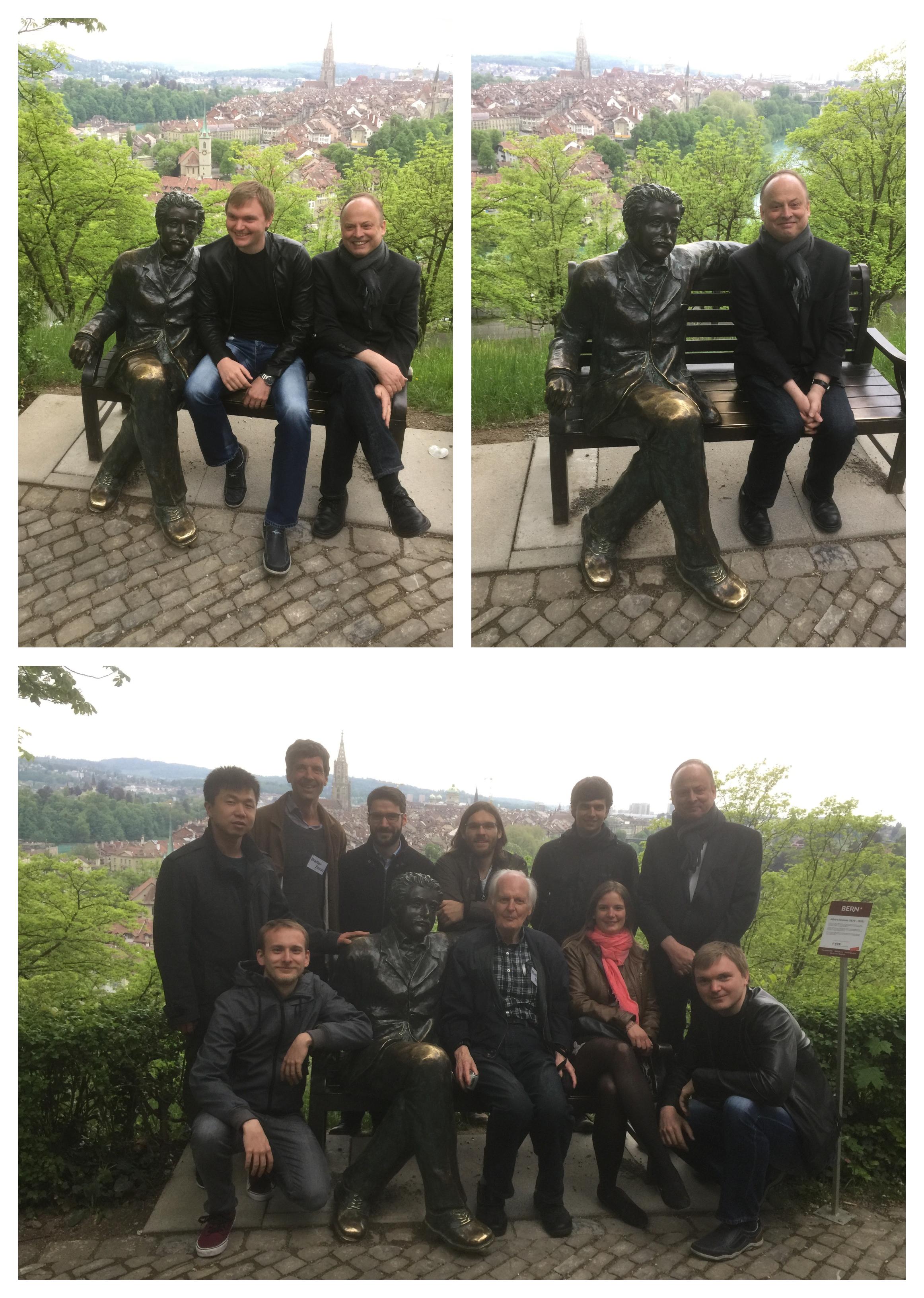
Photo 1&2 Walter Senn, Bern, Group Photo: Passerby (May 2018)
Karlheinz’ passing away is a huge loss, for the HBP, the Kirchhoff Institute, the theory groups in Heidelberg and Bern, and also for both of us personally. The way Einstein cordially puts his arm over Karlheinz' shoulder is a symbol for his own style of leadership, the way it felt for many of us, and particularly for us two. Karlheinz himself was a humble man and it was only with a smile and his good dose of humor that he allowed us to take the picture of him, sitting together with Einstein on the bench with the view over the old city of Bern. We all felt that this scene was a beautiful allegory of that wonderful spring day we spent discussing the vision of merging neuronal theories and neuromorphic computing. We were impressed at how deeply Karlheinz followed our ideas of a mathematical and physical description of the neuronal dynamics, and how he immediately transformed them into new options of improving the neuromorphic design. It is with his unique vision, enthusiasm, positive spirit and drive that he paved the road for us to move into the future.
Walter Senn (SP4) and Mihai Petrovici (SP9)
CDP5 - Biological Deep Learning
*****
This morning we received the tragic news that our great colleague in the Human Brain Project Karlheinz Meier has passed away. Karlheinz was an extremely dedicated and treasured colleague, a pillar of the HBP, and his passing, at a far too young age, is a huge loss to us as colleagues, and to the work of the HBP. None feel the loss more acutely than his family, and we extend our deepest sympathies to them at this moment of sadness and profound grief.
Lise Bitsch
Manager SP12 - Ethics and Society
(on behalf of Kathinka Evers and the whole group of Ethics & Society in the HBP)
*****
It was a pleasure and a true honor to have had the possibility to get to know Karlheinz and to work with him on the groundbreaking phase of the HBP.
Karin Blumer & Henrik Walter
HBP Ethics Advisory Board
*****
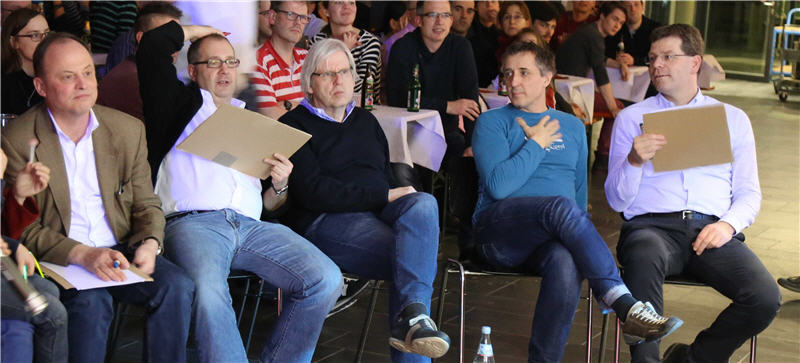
Karlheinz Meier on 21 December 2016 with collegaues at a Christmas party at KIP - Image: Bjoern Kindler (HBP)
*****
It is hard to believe a person like Karlheinz passing away only days after an event, where his strong role in the Human Brain Project became again so visible. A role that resulted from his intuition for communicating the project. This and his passion for realising is vision of neuromorphic computing are an irreplaceable loss.
Dirk Pleiter
SP7 - High-Performance Analytics and Computing Platform
*****
We learned the sad news earlier from Andrew, and we are all shocked here. We "recruited" Karlheinz in the early 2000's at a meeting in Brussels to find matching partners for EU grants. We were together in 4 FET grants, SenseMaker, FACETS, BrainScales, and now the HBP. It was a long history together, where we could admire his talent as a scientist and orator, giving exceptionally clear lectures. We are missing a fundamental person for the HBP and it is now our mission to honor him by making sure his work is continued in the best conditions.
Alain Destexhe
Leader SP4 - Theoretical Neuroscience
*****
Very, very sad...During the turmoil that HBP has gone through Karlheinz has always been a sound force to rely on with common sense and the ability to find solutions while maintaining the original vision of the flagship! Of course HBP is only a small part of the surrounding world and family that are now mourning him.
Sten Grillner
Deputy Leader SP1 - Mouse Brain Organisation and Interspecies Comparisons
*****
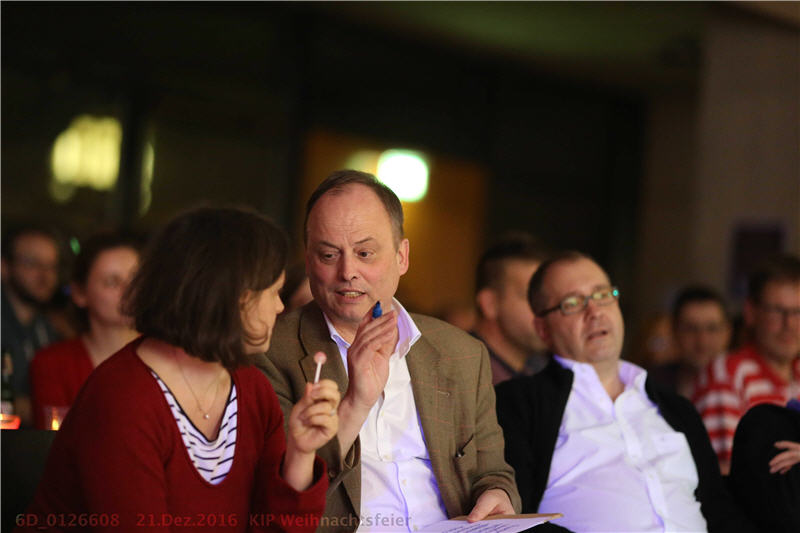
Karlheinz Meier on 21 December 2016 at a Christmas party at KIP - Image: Bjoern Kindler (HBP)
*****
Whooo….what a sad and heartbroken sudden news. We just hugged, talked and encouraged him in Maastricht – let this be a small comfort to a very special, unique friend, colleague, "Mensch" by all means & point of view. My condolences to his family and all who had the privilege to know him. Mein tiefstes Beileid!
Mira Marcus
Deputy Leader SP8 - Medical Informatics Platform
*****
During our recent meetings in Düsseldorf and Maastricht I was once again struck and impressed by Karlheinz energy and drive, pushing the project and us all forward towards a bright future for European neuroscience. It is a great pity that he Karlheinz does not live to see the fruits of his tremendous efforts. Our thoughts go to his family and friends.
Hans Ekkehard Plesser
Deputy Leader SP7 - High-Performance Analytics and Computing Platform
*****
Last week I asked Karlheinz about AI white paper and he said that he will write that in the next few weeks. Karlheinz was undoubtedly a great scientist and a role model. His death is a big loss to science and of course HBP. My condolences go to his family.
SP12 Bernd Stahl
*****
I did not have the chance to know Karlheinz as well as you did, and regret it. However, my few encounters with him were sufficient to stress his unique character, visionary mind, and sharpest intelligence. I was even more impressed by his incredible strength, dedication and bravery in dealing with his condition, which we discussed together. I know he will remain our flagship. Please send my warmest regards to his family.
Philippe Ryvlin
Leader SP8 - Medical Informatics Platform
*****
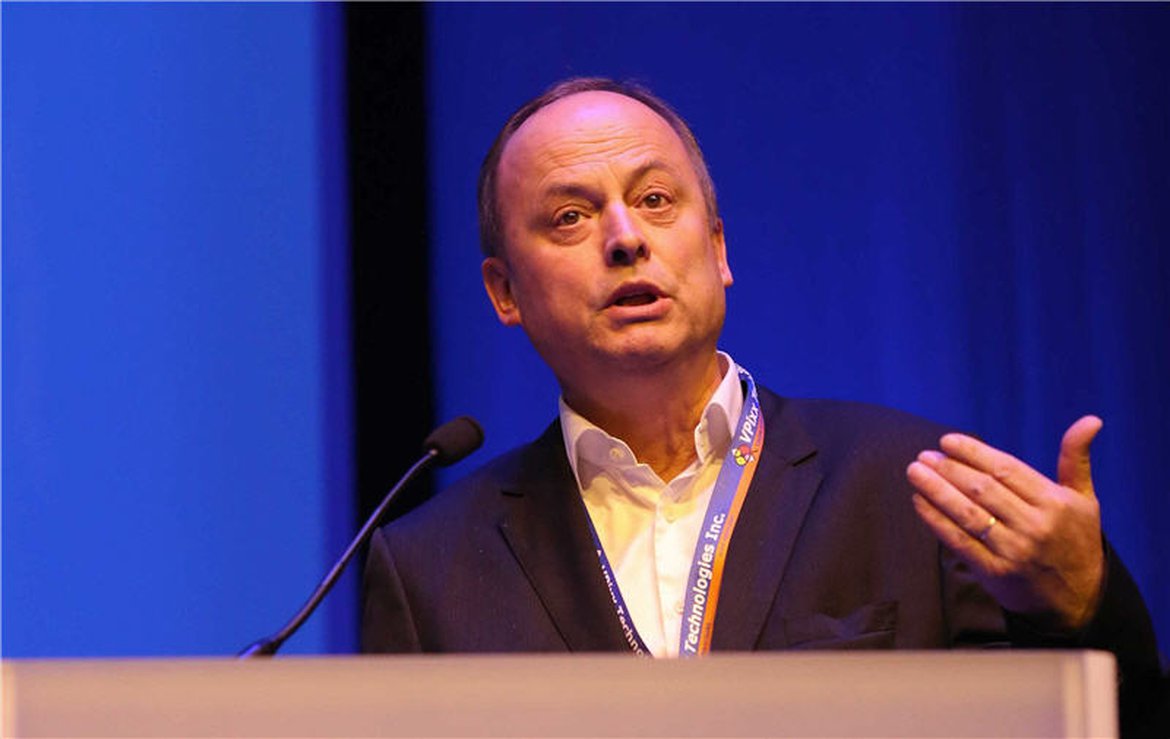 Karlheinz Meier at the HBP Summit in Glasgow, 18 Oct 2017 - Image: Bjoern Kindler (HBP)
Karlheinz Meier at the HBP Summit in Glasgow, 18 Oct 2017 - Image: Bjoern Kindler (HBP)
******
This is really shocking news! While I have not worked closely with Karlheinz, I was deeply impressed about his enormous efforts for the HBP and his amazing leadership qualities! He also helped me making the open day of the summit such a success by playing a key role in convincing Jeff Hawkins to come to Maastricht. My sincere condolences to his family and friends!
SP2 Rainer Goebel
******
I am very saddened by the news. Such a privilege to have met him. Karlheinz has been a huge inspiration, a visionary, and a powerhouse. Big loss for all of us. My condolences to his family and close friends.
Lars Muckli
Deputy Leader SP3 - Systems and Cognitive Neuroscience
******
This is very sad news, he was an inspiring person, and is gone far too young. And what a huge loss for the HBP. Let us hope that the project can continue his work and fulfil his ambitions.
Nikolas Rose
Foresight Laboratory & Researcher Awareness (SP12)
******
When Karlheinz spoke about extraordinary achievements of colleagues within HBP, he sometimes used the phrase « that XX/XY enters for him on the list of HBP heroes »… I have always felt that this is not a bad wording and Karlheinz himself should be somewhere on the top of this list.
Viktor Jirsa
SP4 - Theoretical Neuroscience Deputy Leader
******
I'm really saddened by the news! Karlheinz was a rare combination of a creative mind and a kind heart, a true inspiration. It has been an honor to have met him and to have worked with him within HBP. Expressing, I'm sure, the sentiment of everyone at SP8, I offer my condolences to his family and close colleagues and friends.
Yannis Ioannidis
Co-Leader SP8 - Medical Informatics Platform
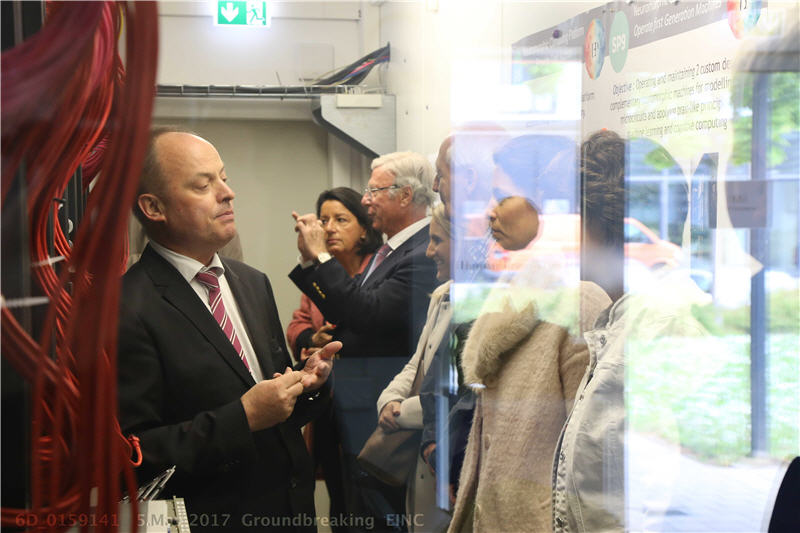 Karlheinz Meier on 5 May 2017 explaining the BrainScaleS system inside the machine room in the HBP Container - Photo Bjoern Kindler (HBP)
Karlheinz Meier on 5 May 2017 explaining the BrainScaleS system inside the machine room in the HBP Container - Photo Bjoern Kindler (HBP)
**** ENDS ****



